Or – “Crisis On Infinite Oddities…”
As we’ve mentioned previously, the comics publishing world has developed a “Big Event” mentality, and crossovers have become the norm for the big publishers. In the ’80s, in the wake of ‘Secret Wars’ and ‘Crisis On Infinite Earths,’ a number of publishers created their own universal opus to cash in on the crossover craze. One of the weirdest was Total Eclipse, from Eclipse Comics, publisher of titles as diverse as Miracleman, Adolescent Radioactive Black Belt Hamsters, Tales of the Beanworld and more. The big question going into this book wasn’t what the threat was, it was how in the WORLD they were going to get these characters in the same UNIVERSE, much less the same room.
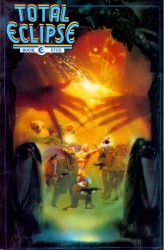 Total Eclipse #5 (of 5)
Total Eclipse #5 (of 5)
Script: Marv Wolfman
Pencils: Bo Hampton; Larry Marder
Cover: Bill Sienkiewicz
Inks: Rick Bryant
Colors: Sam Parsons (painter)
Letters: Bill Pearson
Published by Eclipse Comics
Previously, on Total Eclipse: An immortal madman named Zzed has become disenchanted with his endless life, and has tried to find a way to kill himself… Teaming with an undead airman called Misery and various other unsavory types, he has created a device that will destroy ALL the universes, everywhere. In an attempt to stop him, heroes of all shapes and sizes have come together (thanks to the time/space machinations of the man called Aztec Ace) to bring him down. Ironically, Zzed himself has been transformed by his own plans, becoming a new being called Doctor Eclipse, who realizes how foolish he has been. Unfortunately Misery, with the assistance of Aztec Ace’s archfoe Nine-Crocodile, has continued with the plan for Armageddon, creating the worldbreaking device that would bring about the end of everything. Now, a desperate band of heroes from various worlds have to fight off the coming apocalypse, but not without casualties…
Having lost Strike!, the heroes are confused, especially the young man who is working to take up the mantle of the Prowler, Scott Kida. It becomes clear that they’re dealing with dead serious business here as Nine-Crocodile paradoxical battle-machines attack. Scott’s erstwhile mentor, the original Prowler, tries to give him a pep talk, only to have Scott go off on him. “We’re just leaning not to be kids anymore and then you guys dress us up and fill us with stories and let us DIE?” Where many hero-types would be taken aback, The Prowler just punches his protege in the face and tells him to grow up…
Aztec Ace’s contingent is forced to go on the run, while a second team, led by Airboy and Skywolf arrives at their destination, only to get ambushed by Nine-Croc’s mercenaries (known colloquially as the Knightgaunts and Ebonati.) The retreat into a cave, to find reinforcements in the form of the Adolescent Radioactive Black Belt Hamsters. (They’re actually pretty much self-explanatory. The concept is, anyway…)
Burnout and Slick work together to take out the Ebonati, and Destroyer Duck nearly loses his life before they make their way to Misery’s zappy kablammicus device. Liberty Project leader Slick has a plan…
While that goes on, Strike!’s predecessor (named Sergeant Strike, oddly enough) talks the young Prowler out of his bad mood by giving him an old school Captain America talking-to. Much fighty-fighty ensues as the assembled heroes vie to destroy the ziggurat at the end of the world (which should be a Doc Savage title, honestly) as the differences between the heroes (and the villains) of many different world becomes more and more clear…
Even the bad guys hate the bad guys… Doctor Eclipse believes that Nine-Crocodile is nothing but a diversion for Misery’s plan, but Aztec Ace can’t believe that his old foe is blameless in all this. Unlike many crises, the heroes aren’t sure that they should even trust one another, much less how to go about saving the world, which I kinda like.
Thanks to Avalon of the New Wave, the heroes realize that to breach Nine-Croc’s fortress, they need to attack on all fronts simultaneously. When they do, they find The Anti-Monitor’s antimatter cannon Misery’s thingamajig…
The device is nearly impenetrable, covered with a force field, and invulnerable to even Miracleman’s might. How can they ever destroy it? I wonder if there’s a hole in their armor, maybe a plasma vent, no bigger than a womprat?
Even the futuristic mind of Nine=Croc only protected his machinery against human organic matter, never expecting that one of the denizens of the Beanworld would make his way out into the Big, Big Picture. Though an artist at heart, Beanish makes his way to the center of Croc’s doomsday device, allowing Miracleman to identify the power source as Warpsmith technology (and that, my friends, is some bad mojo.) The heroes gather their forces and attack ON ALL FRONTS at once, even as Beanish destroys the power core.
That’s one of the best “Running Away From An Explosion” moments in my memory, mostly because I can clearly hear Beanish screaming in terror as he runs away. The heroes of a dozen different realities and continuities run like hell as the future planet known as Five Worlds loses an entire layer. (If you don’t know what Five Worlds is, just call it a time paradox and move on, I did.)
This series has everything, including a villain who shakes his fist at the sky melodramatically. With the threat to the world defeated, the heroes have an awkward morning-after moment wherein they realize that they have nearly nothing in common now that the universe isn’t destroyed and all. They have strange dystopian realities, dark pulpy worlds and floating islands full of legumes to get back to…
Heh… I love the reaction to Scott’s Justice League idea, especially the look on Bridget’s face on the left. The heroes return to their various realities, thanks to Aztec Ace, while Misery watches and laughs maniacally from the shadows. So, the basic thing of it is that the villain became a hero, and neither of the remaining villains was brought to justice or even captured. Add to that the madness of it all (Eclipse’s publishing at this point consisted of a couple dozen different realities, including the revived characters from Hillman Publications.) and the fact that Eclipse’s publications didn’t last much longer after this crossover, and you’ve a recipe for 80’s comic boom madness. I pride myself on having collections of Miracleman, The Liberty Project, Aztec Ace and several others (and I’m working on a run of Destroyer Duck, which are harder to come by than hen’s teeth these days) and even *I* don’t have a clear understanding of what this is all about. Bo Hampton does good work with the art, although his facial expressions tend to be a bit on the grotesque side, and a character like Bridget (who is hotter than donut grease in her original stories) ends up kind of scary looking. Still, it holds together as well as a story about frozen WWII aviators, flying guys, juvenile delinquent supers, hamsters, ducks and a bean teaming up to fight evil can, I suppose, thanks to Marv Wolfman. And I will say that re-reading this, I do kind of miss some of these four color old friends, and I love the fact that Beanish is key to the heroes eventual plan. (My daughter has discovered Tales of the Beanworld in the last few months, and we’ve enjoyed reading it together…) Total Eclipse is total chaos, but a fun kind of chaos, which might make you want to go digging through the back issue bins for answers to its mysteries, and earns 2.5 out of 5 stars overall.
Faithful Spoilerite Question Of The Day: Anybody else have fond memories of the Eclipse days? Sabre? Liberty Project? Reid Fleming? The DNAgents?




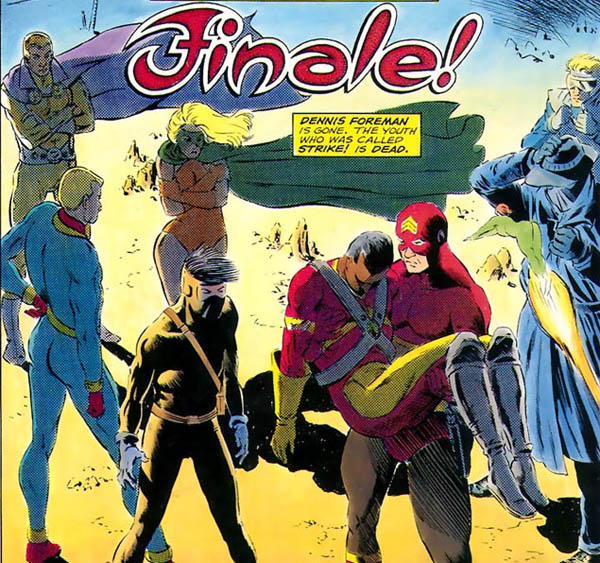
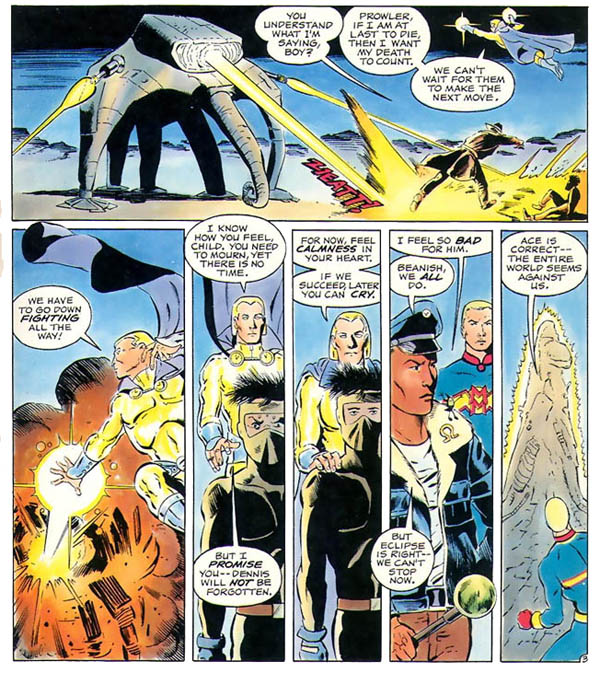

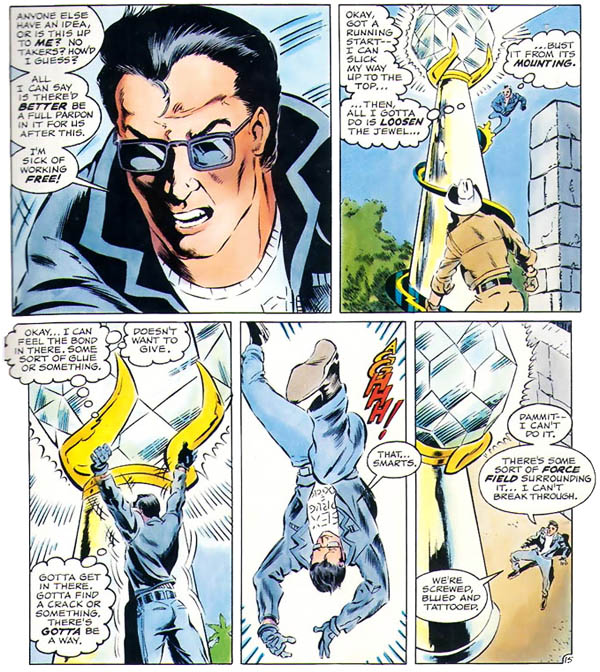
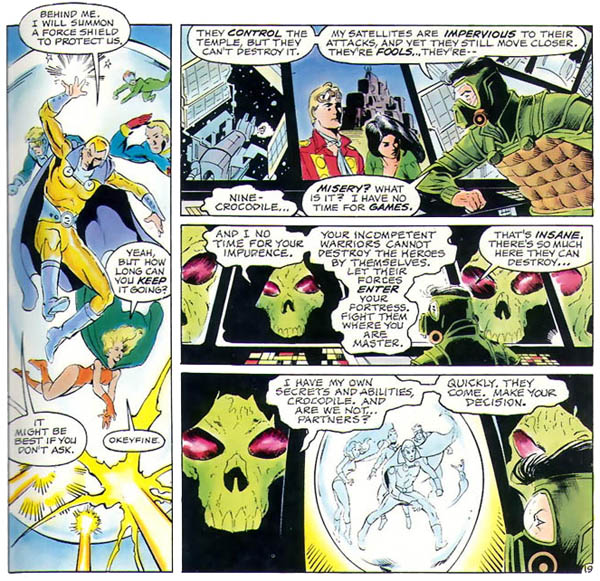

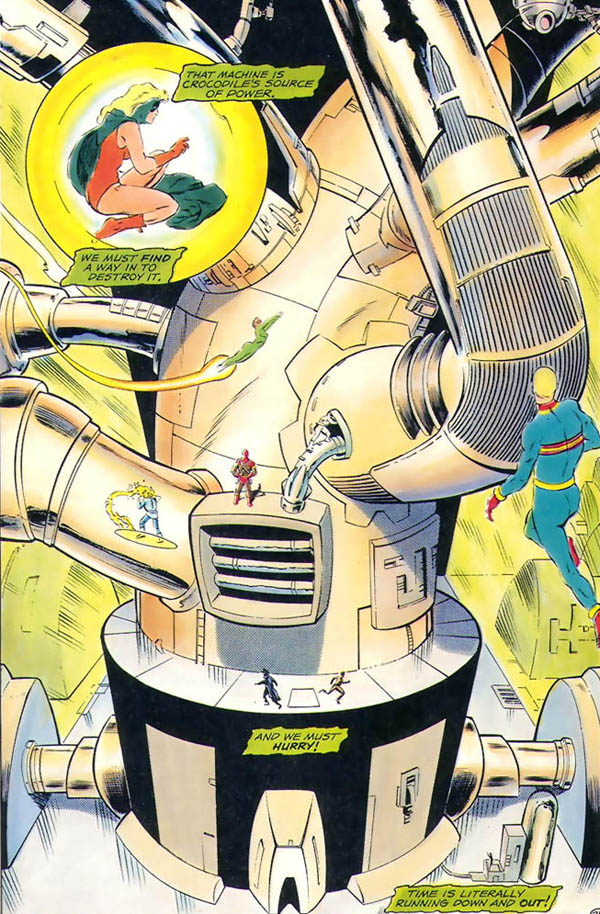
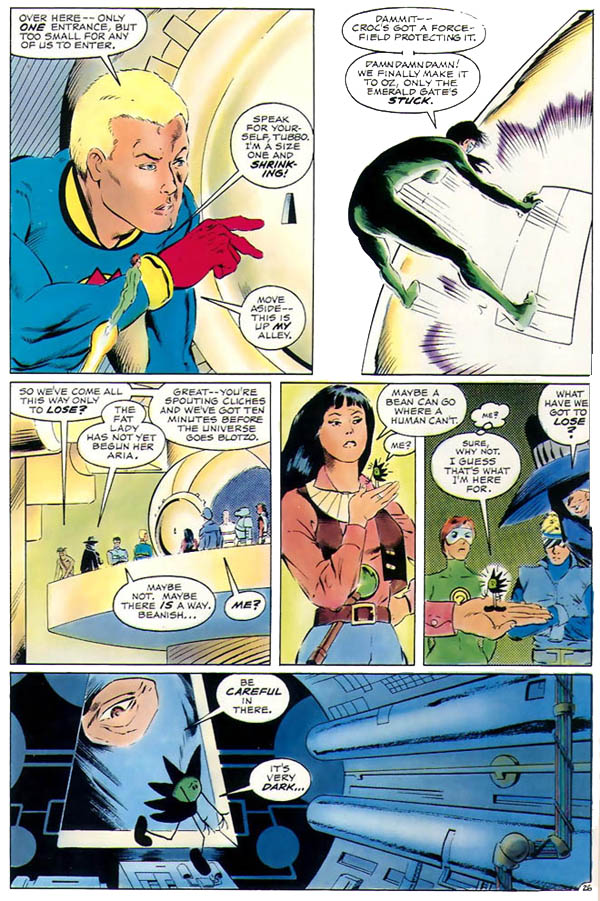
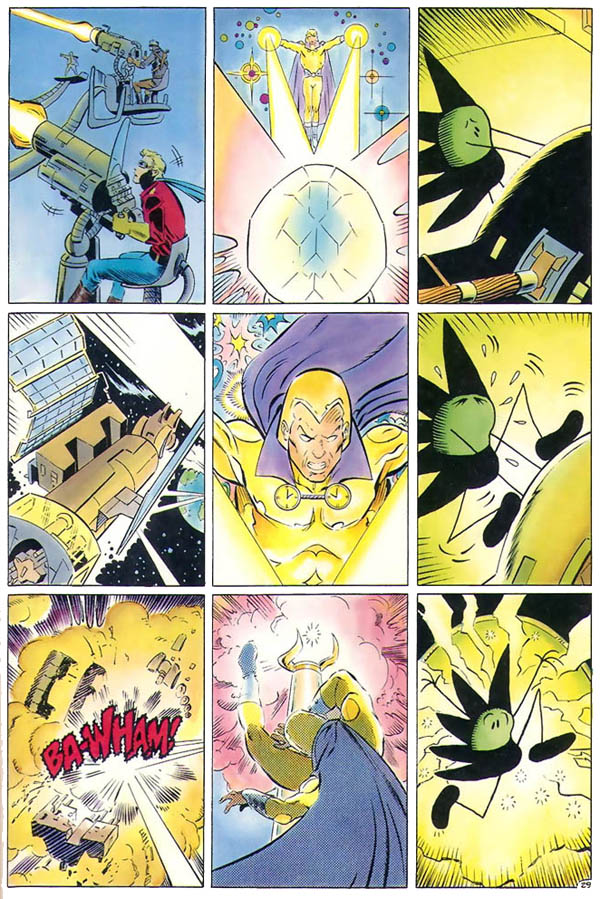
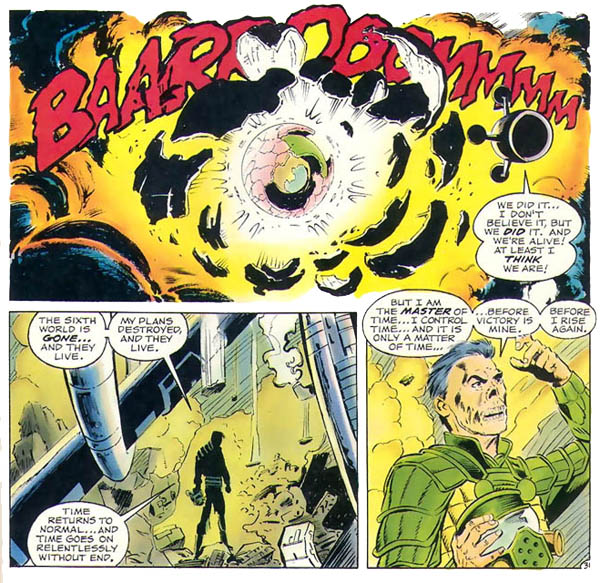
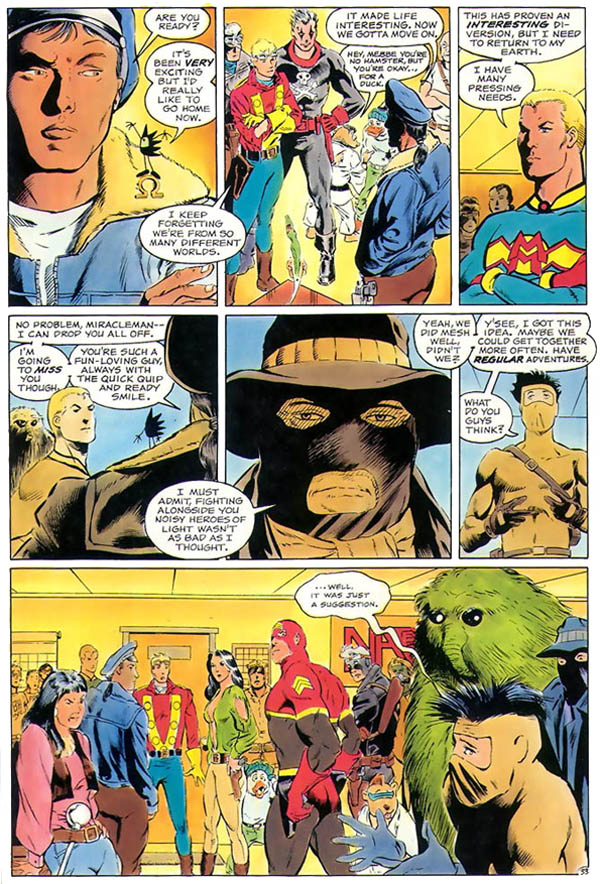
7 Comments
The fact that there IS a beanworld crossover just blows my mind. Who reads that comic and thinks “Hey, you know what? These beans should team up with someone to save the world.” Sheesh.
The fact that there IS a beanworld crossover just blows my mind. Who reads that comic and thinks “Hey, you know what? These beans should team up with someone to save the world.” Sheesh.
It’s not just that… Eclipse published all sorts of comics, and most (if not all) of their characters appeared, including Ms. Tree, the California Girls (an Archie-like series about twins and their love of boys and fashion) and the aforementioned Miracleman. I think the idea was “Let’s send up these universal crossover events by doing one!”
And frankly, it’s Beanish’s moment of heroism that sells the climax, for me. He hadn’t had a lot to do other than stand on Ace’s collar and look confused by it all for most of the series…
I’ve always wanted to pick these up, but ONLY for the great Bill Sienkiewicz covers. But every time (even in dollar bins) I just can’t do it. LOL
I just recently read this series for the 1st time a month or two ago. The completist in me wanted any and all Miracleman appearances. I considered including this in my eventual realization of having a bound Miracleman compendium.
Then I read it.
In the last panel, who is the big green guy that kinda looks like Man-Thing?
In the last panel, who is the big green guy that kinda looks like Man-Thing?
That would be the Heap, the original swamp man, from the Hillman Publications library, revamped and revitalized as part of the Airboy cast in the ’80s.
Hey thanks, good job bringing another crazy title up to me. I’d heard of the Adolescent Radioactive Black-Belt Hamsters kind of in passing, but hadn’t really heard about any of the other guys before. I’ve heard you all mention Beanworld, but I know absolutely nothing about it, apparently it’s about beans. Cool either way. Maybe there’s something obscure and great from Eclipse Comics or Now Comics or even Malibu that you’d want to review sometime.